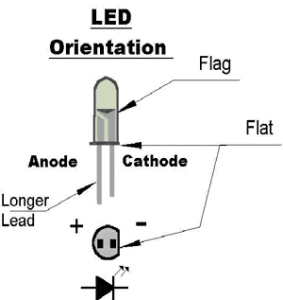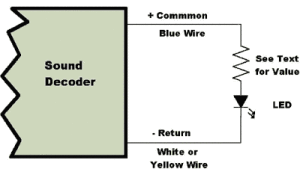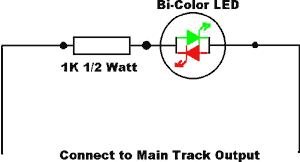Installing LEDs with DCC Decoders
Download in PDF format (43 kB)
Thanks to Don Fiehman for drafting these handy tips for using LEDs and Low Voltage Lamps with DCC.
This series of tech notes is designed to help modelers with DCC decoder installation. Much of the information comes from questions asked by modelers and ideas we have found. This note covers using LEDs (Light Emitting Diodes) with DCC decoders and signaling.
Why use LEDs
When installing lighting in a locomotive you have a chose of either lamps or LEDs. There are reasons to chose one over the other. Factors to consider are life, cost, size and ease of installation. Lamps have been with us for a long time. LEDs are newer and the technology of LEDs is changing for the better.
The first visible color LEDs were red followed by yellow and then green. In the last few years white LEDs have also become available. The first white LEDs had a blueish tint that did not look like an incandescent locomotive headlight. Recently the Golden-White, Yeloglo and Sunny-White LEDs have changed this. These new LEDs produce colors that are closer to that of an incandescent lamp. These new LEDs are now installed in some of the new locomotives, supplied with some decoders and available through many model railroad suppliers. The cost of LEDs is just a bit more than lamps, but well worth it over time. When installed correctly an LED will outlast the locomotive.
LEDs are available in different sizes. They run from the jumbo at 10 mm to a very small “chip” size that mounts on circuit boards. The common sizes are 3 mm and 5 mm. The 3 mm is the best for HO headlights. LEDs are also available in range of colors. Red, green, yellow, blue and white are the common colors. The LEDs that are made to resemble the yellow-white appearance of color of an incandescent lamp are the Golden-White, Sunny-White and Yeloglo. The Golden-White is made with an amber color epoxy that filters out some of the blue. OK when on but shows the amber color when off. The Sunny-White and Yeloglo LEDs have the incandescent appearance when lighted and clear when off.
Lamps vs. LEDs
The LED has many advantages over lamps. LEDs have a life expectancy rated in years and not hours as a lamp. LEDs are better at producing light. Lamps produce heat and some light, LEDs produce light and some heat! The light from a LED is much less sensitive to changes in voltage and current than lamps. The maximum current rating of most LEDs is 20 mA (milliamps). The light output from a LED is almost constant from about 5 mA to the maximum (about 20 mA).
LEDs need the correct polarity to work
The light from a lamp is not focused and is good for passenger cars and buildings. When in a locomotive they put out some light through the headlight and in many cases end up also lighting the interior of the cab. LEDs produce a beam of light like a flashlight. This is why they work so well in the new LED flashlights. This is also why LEDs work so well for headlights, signals and panel indicators. In a darkened layout room an LED headlight can light up the area in front of the locomotive like a prototype headlight.
One problem with LEDs is they do not respond the same as lamps. LEDs turn on and off instantly. Lamps must heat up and cool off. This does not affect use as a headlight or strobe light that is just on, but can act differently when dimmed or used with special lighting effects. The response of the LED vs a lamp may not be satisfactory with things like dimming and Mars lights. To compensate for these differences when using special lighting effect many of the newer decoders have provisions to let the decoder know it is operating an LED. This is a bit in the CV that controls the special lighting. When on this bit changes the output characteristic to match the LEDs . This lets the LED appear to response like an incandescent lamp. I checked one of these decoders and found that for “Rule 17" dimming the power was reduced to under 10% for the LED and only 35% for a lamp.
A 1K (1000) Ohm 1/4 Watt resistor will work. If space is tight use a 1.5K 1/8 watt resistor.
Wiring LEDs
When connecting an LED to a decoder a resistor is required to reduce the voltage. Different color LED run on slightly different voltages. Unlike lamps that require you to select a value of resistor to match the lamp, selection for LEDs is easy. A 1K (1000) Ohm 1/4 Watt resistor works fine with 10 to 14 volts on the rails. If using more then the standard 14 volts use a 1/2 watt 1K resistor. If space is at a premium even a 1.5K Ohm 1/8 Watt resistor will work. Up to 3K can been used when the LED is too bright. I have seen as low as under 400 Ohms used as a dropping resistor. This resistor value is much too low for use on DCC and will generate more heat than light.
The LED is a Light Emitting Diode and polarity must be observed when they are installed. Decoders have a common connection to power all of the function outputs. The common output is positive connection and the function outputs are a negative return connection. One resistor is needed for each LED connected to a function output. If you have two LEDs that will be controlled by the same function the LEDs can be wired in series and share the same resistor. LEDs work better in series than in parallel because the same current flows through both LEDs. I have used up to 3 LED in series with a 1K resistor. (Two red for rear markers and one white for a headlight.) The resistor can be connected to either end of the LED.
When you solder wires to an LED it is a good idea to use a heat sink between the LED and the solder joint. A heat sink can be a long nose pliers with a rubber band around the handles. The rubber band will keep the pliers closed and trap the heat before it gets to the LED. Hint: If you are using heat shrink tubing on the wiring, slide the tubing over the wires before making the connection.
An LED does not generate much heat. This simplifies installation in a plastic body shell. The LED can be mounted directly to the plastic body shell without fear of damage to the shell due to heat from the LED.
Signals and Indicators
Another application for LEDs is in signals and as panel indicators. The colors used for signals are green, yellow, red and in some cases even blue. Over 30 years ago I installed many colored lamps in a control panel. LEDs were new, but I did install a few in the panel. I also used bicolor LEDs for searchlight signals. The coating on many of the lamps has faded over the years, but the LEDs are a bright as the day they were installed. In control panels the 5 mm works best for me. For signals the 3 mm size works best in HO. A voltage dropping resistor is needed in series with the LED in most applications, The 1k resistor should work for 6 to 14 Volts DC.
The bicolor green-red LED not only produce a nice green and red color by switching the polarity for a searchlight signal, but can also produce yellow. Yellow is made by turning on both the red and green LEDs. To accomplish this alternating voltage (ac)is fed to the LED. The eye will be tricked into looking like yellow.
You can also use a bicolor LED to monitor the status of the track power. Normally it is a yellow/amber, a distinct red or green indicates a DC output bias and may be indication of a malfunction.
Available LEDs at Tony’s
We stock a variety of LEDs in different sizes and colors. Check our website for a list of available LEDs at discount prices or call us at 1-800-978-3472.



